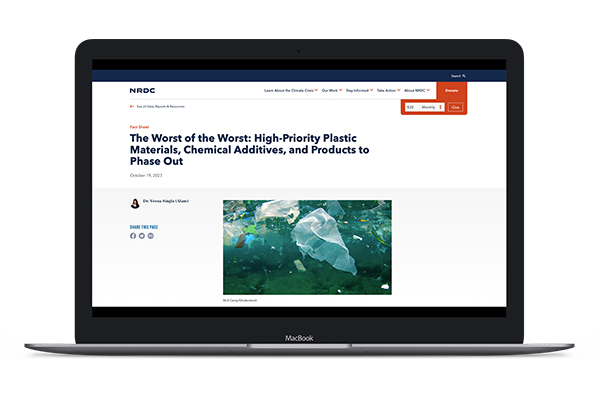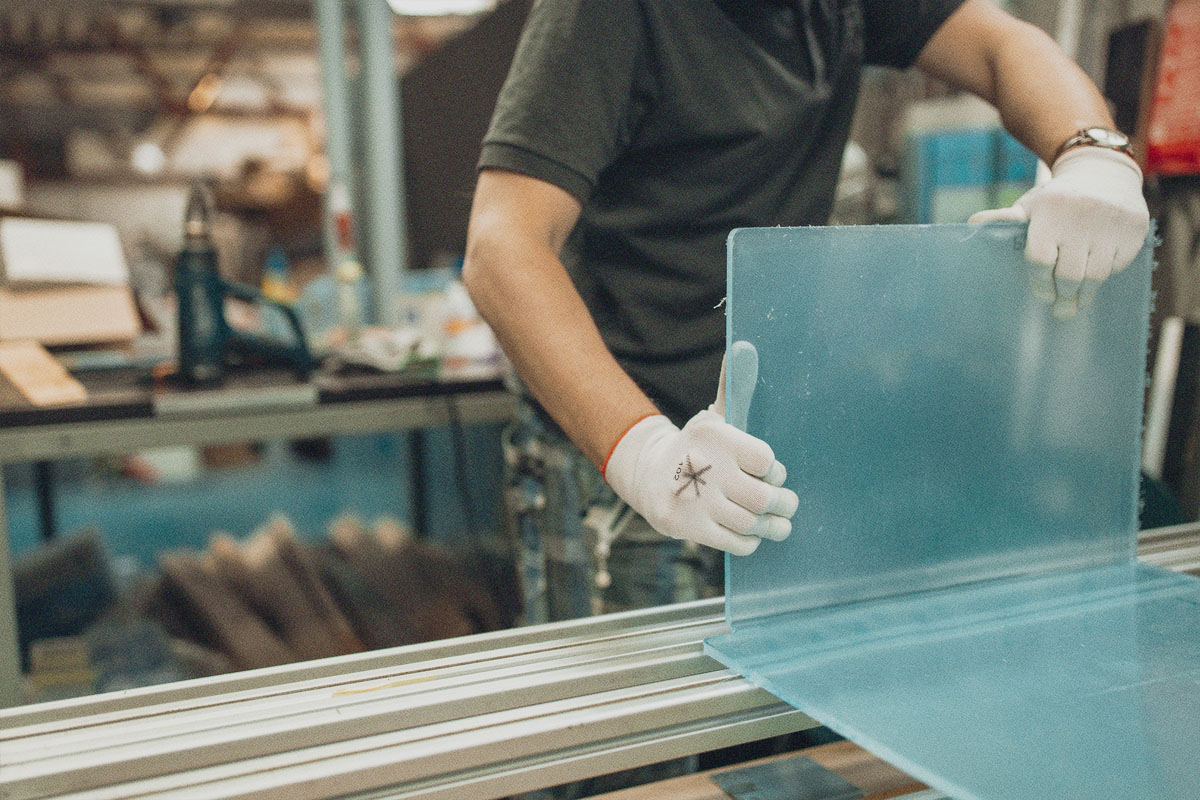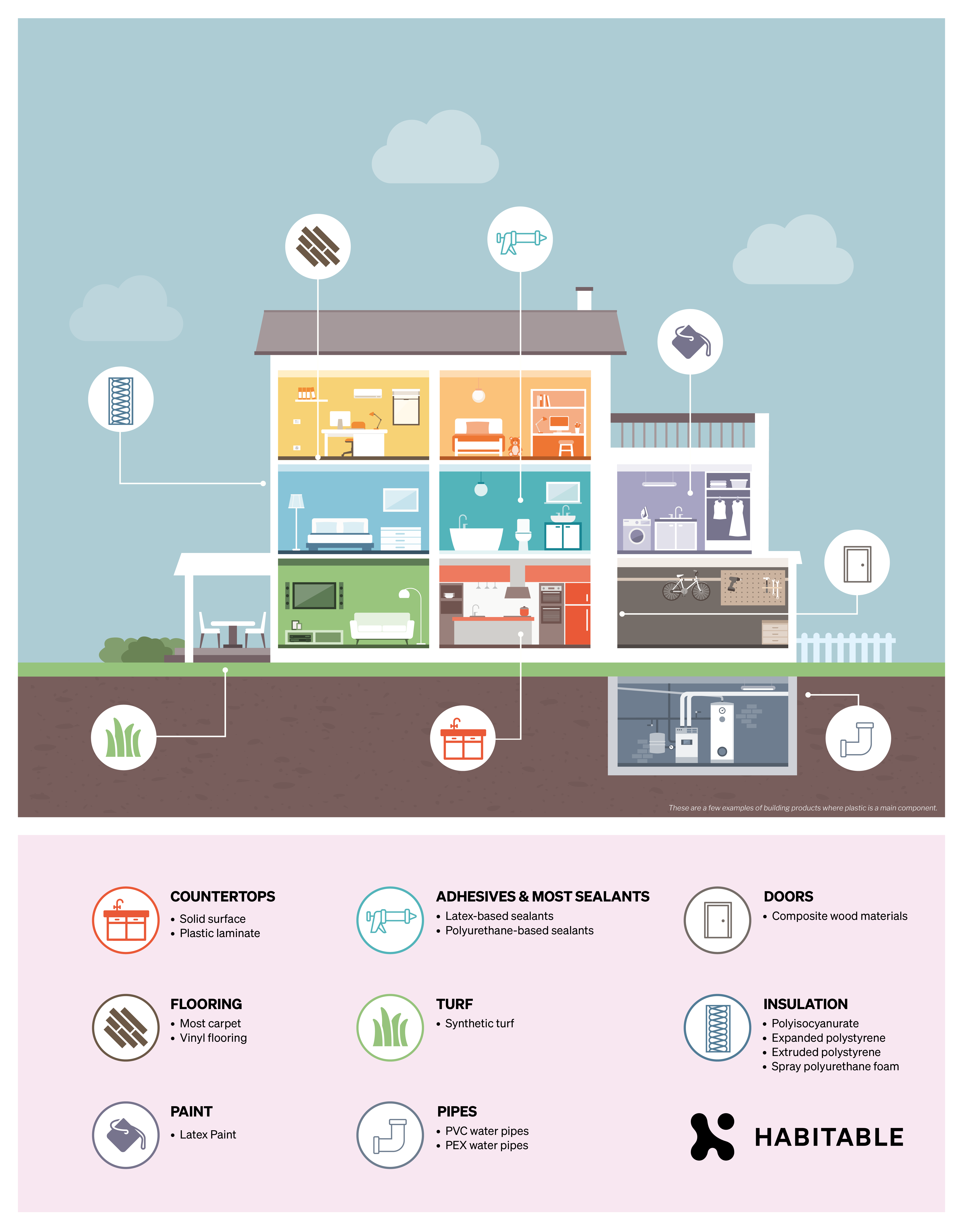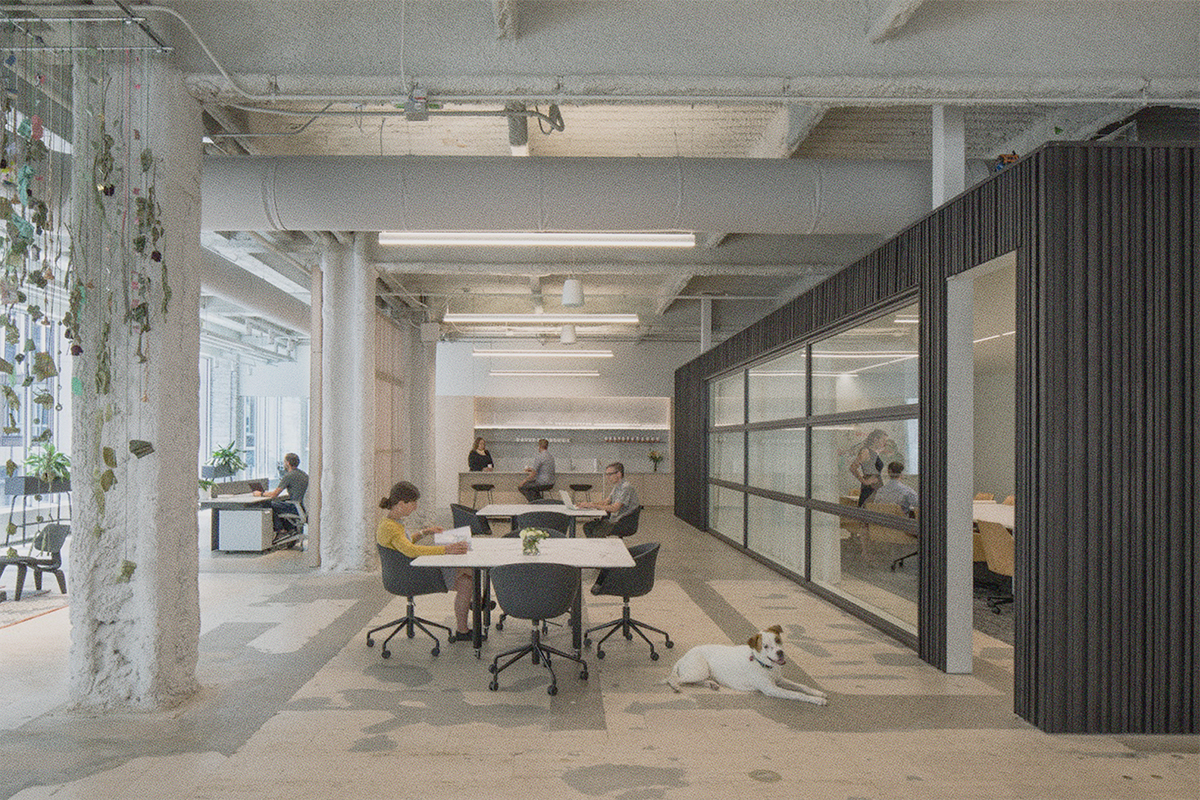 READ HABITABLE’S NEW REPORT
READ HABITABLE’S NEW REPORT
A new report reveals that low-income countries, despite using less plastic, face lifetime plastic costs that are ten times higher than those of wealthier nations.
This disparity highlights the structural inequities within the plastics value chain, where the burdens of plastic pollution fall disproportionately on those least equipped to address them, exacerbating the crisis. WWF urges all governments to adopt a treaty with harmonized, binding global rules to eliminate these inequities in our current take, make, and waste plastics system. Such a treaty is essential to ensure a fair and effective global response to plastic pollution.

The American Chemistry Council promotes chemical recycling as a solution to plastic waste but this article highlights concerns raised by environmentalists about its efficacy and environmental impact, as well as the lobbying efforts to reclassify it as manufacturing in 24 states.

This article provides an overview of the global plastic waste crisis, highlighting the environmental impact of plastic pollution and the ongoing efforts by the UN to create a legally binding international agreement to address the issue.
This fact sheet highlights the urgent need to phase out the production and use of high-priority plastic polymers, chemical additives, and products that pose significant hazards to human health and the environment, in order to address the global plastics crisis.


This fact sheet provides an overview over plastic pollution at each life stage: from resource extraction all the way to removal and remediation.
We have been picking on plastics a lot recently (see articles: Addressing the Plastic Crisis: Why Vinyl Has to Go and The Illusion of Plastic Recycling: Neither Just Nor Circular). This is because we believe that typically the best way to avoid hazardous chemicals is to avoid plastic altogether. With this said, we recognize plastics in buildings are currently ubiquitous (see article: Our Plastic Buildings: A New Driver of Fossil Fuel Demand).
So, let’s consider what would need to happen for plastic building products to be considered truly sustainable. Can the plastics industry do better? What are the key opportunities today to do so, and what global policy tools could promote these opportunities? These are among the key questions HBN explored in the development of a pair of case studies for the international Organization for Economic Co-operation and Development (OECD) as part of the Inter-Organization Programme for the Sound Management of Chemicals (IOMC).
Before we jump into the case study findings, first, let’s define plastics. For the purposes of this article, we define plastics to be any polymeric material, fossil fuel based or bio-based. The case studies focused on durable plastic goods, using building materials as an example.
The case studies explored both plastic flooring and plastic insulation with the goal of increasing awareness of environmental and human health impacts of plastic product production at each stage of the lifecycle and proposing policy interventions that can help move the industry toward more sustainable plastics products in general.

What would be defined as a sustainable plastic?
In the report, we created a framework for evaluating what a truly sustainable plastic product would look like. These goals are lofty, and currently no existing plastic building materials meet these goals. However, they provide a pathway towards truly sustainable products.
To be considered a sustainable plastic, a product would have to enhance human and environmental health and safety across the entire product life cycle. It would have to be managed within a sustainable materials management system, and would have to meet the following goals:
- Must be inherently low hazard.
- Hazardous substances are eliminated.
- Transparency in terms of content and emissions exists at every step of the supply chain.
- Full hazard assessments are available on all chemicals.
- Must have a confirmed commercial afterlife.
- Products designed for durability, reclamation, reuse, and recycling.
- Infrastructure exists to support reclamation, reuse, and recycling.
- Materials can undergo multiple cycles of recycling.
- Must generate no waste.
- Manufacturing scrap is eliminated at every step of the production process.
- Scrap from installation is eliminated.
- Must use rapidly renewable resources or waste-derived materials.
Trade-offs examples
The case study explores trade-offs that exist between different material choices.
For a flooring example, a product that is designed to use adhesive to install is typically thinner than one that uses a click tile system to install. These thinner products use less material per square foot and therefore have less chemical impacts associated with manufacturing and less waste at the end of life. However, adhesives may add hazardous substances to the product installation stage. By moving from a click tile product to a glue down product, chemical exposure burdens shift from manufacturing and end of life to the installation stage and use phase.
For an insulation example, a product that is designed to chemically react at the build site, such as spray polyurethane foam (SPF), can allow the insulation to form an air-sealed custom fit. However, SPF is not recyclable, and adherence of that insulation to surrounding materials may also make those materials more difficult to reclaim or recycle. Moving from XPS, EPS or polyiso to SPF may reduce the ability of other surrounding materials to “have a commercial afterlife” in the pursuit of an added performance feature.

Building awareness around these trade-offs enables stakeholders to make informed choices.
Back to reality
Now, back to reality after crafting the characteristics of a theoretical sustainable plastic. The bottom line is that there are no sustainable plastics that exist today, and we are a long way off from that day. Today, project teams need to prioritize which sustainability goals are most important and how to deal with real and significant gaps in understanding and/or data.
The case studies compared only product types made of plastic, but in reality, project teams have a wider variety of materials to choose from in any given product category. HBN’s Product Guidance considers the most commonly used product types within a product category and ranks those product types relative to one another from a chemical hazard perspective. Product types made of plant-based materials or minerals tend to rank higher than plastic products. You can apply the same sustainability goals proposed in this article to non-plastic products.
In project design, the biggest leaps towards more sustainable products from a chemicals perspective often requires consideration of vastly different materials versus making incremental improvements in chemistry for a particular product type. For example, this could mean moving from vinyl to linoleum flooring versus attempting to select the least bad vinyl option.
Check out the full flooring and insulation case studies for examples of how to use these goals to consider and choose the variety of plastic product types you will inevitably be specifying for your next project. Alternatively, challenge yourself to skip the plastics whenever possible. Even selecting one non-plastic product is cause for celebration. Make the swap!
The idea of a “plastic building” might bring to mind Barbie DreamHouses or Lego towers, but probably not the real life spaces we occupy every day. However, plastics have a long history of use in construction and are increasingly being used in a wide variety of building products.
What are plastics?
Plastics are synthetic or semi-synthetic materials typically made from fossil fuels and their byproducts.1 Depending on the plastic’s intended use, they may also be combined with a variety of additives such as stabilizers, fillers, reinforcements, plasticizers, colorants, and processing aids, many of which are toxic chemicals that are linked to chronic disease. They are a material of choice in the built environment, however, they come with a host of deeply rooted problems.
Durable plastics are the new “frontier”
As the energy sector shifts away from fossil fuels, the fossil fuel industry has turned toward plastics as a way of maintaining demand for their products.2 An International Energy Report from 2018 showed that petrochemicals, which are used to make plastics, are slated to become the largest driver of global oil demand in the near future.3 Historically, much of the investment has been in single-use plastics, which are increasingly the focus of bans, restrictions, regulations, and product innovation due to their harmful environmental effects.2 To pick up this anticipated slack, petrochemical, fossil fuel, and plastics industries are now pushing to increase their market growth in more durable goods, like building materials.4 The building and construction industry is already the second largest consumer of plastics after packaging.5
Plastics contribute to climate change
Plastics contribute to greenhouse gas emissions at every stage of their lifecycle. Greenhouse gases are released during fossil fuel extraction, transport, feedstock refining, and plastic manufacture, and carbon is released into the atmosphere through degradation and incineration at plastic products’ end of life.6 A 2019 Center for International Environmental Law report concluded that these lifecycle emissions may make it impossible to keep global warming below 1.5 degrees if growth continues as projected.6 Any comprehensive climate change plan must curb the production of plastics.
Plastic is ubiquitous in buildings
Maybe you know that vinyl flooring is plastic, but did you know that latex paint is mostly plastic? That many insulation products are plastic? How about carpet? Plastic-containing products can be found in almost every part of a building, from the waterproofing on foundations to roofing materials. See below for an infographic showing just some of the plastic materials in an average home. The products included are not exhaustive, but rather a list of example product types from Habitable’s InformedTM product categories where a main component is plastic. There are many more products that are predominantly made of plastic, and even more that contain smaller amounts of plastic additives or plastic binders.
Our plastic buildings are driving the growth in fossil fuels at the same time as we are diligently working to incorporate clean energy solutions and decarbonize these very same places.
Hidden costs of cheap plastic
Plastic products are often favored due to their “low cost.” This low retail cost is achieved by avoiding and externalizing the costs of fossil fuels and industrial pollution – and their related chronic diseases – throughout the plastics supply chain. These externalized costs are real and paid for by the BIPOC and low-income communities across the nation who are disproportionately burdened with toxic pollution flowing from refineries, chemical manufacturing, and plastics plants. It is fair to say that most of the stories about environmental justice that you have heard can be linked to plastics manufacturing.

Where is the plastic in my building?

With the building and construction industries anticipating growth over the next several years,7 commensurate growth is to be expected in their use of plastics. Indeed, market trends and projections show a steady increase in polyvinyl chloride (aka vinyl), polystyrene, polyethylene, polyurethanes, and other plastics used in building materials.8
It is, of course, unrealistic to avoid all plastic in building materials at this time, but there are steps we can take to reduce plastic waste, decrease toxic chemical use, and curb the demand for fossil fuels.
Select Better: Avoid worst-in-class plastics where possible.
- Where product performance and chemical hazards are similar or better, non-plastic products are preferred.
- Not all plastic products are the same when it comes to impacts. Where plastic products are needed, avoid halogenated plastics or plastics reliant on halogenated chemistry during production – such as polyvinyl chloride (PVC, also known as vinyl) and epoxy-based materials.
- Where plastic products are needed, avoiding virgin plastic materials reduces demand for oil and gas extraction and ultimately mitigates harmful end of life scenarios for the plastic waste such as incineration or landfilling.
Prioritize Transparency: Prefer products that provide transparency
- Disclosure of product content including the type of plastic used and any potential additives will allow for healthier materials choices and better material end-of-life planning.
- In the case of products containing recycled plastics, disclosure of where the recycled content originated and any additives that may be present is crucial in selecting healthier products.
Aim for Circularity: Select products designed for recycling.
- Where possible, incorporating recyclable building materials in ways that allow for end-of-life recycling is preferred.
- Prefer products with “take back” programs. Because true plastics recycling rates are abysmal, the most promising recycling programs are those in which manufacturers retain responsibility for their products and provide recycling options.
- Prefer products that are made with high levels of recycled content that has been screened to avoid toxic tag-alongs and, equally as important, contact manufacturers to recycle any existing product.
With all of these plastic products, our buildings may seem increasingly like Barbie’s DreamHouse and a climate nightmare, but as specifiers, designers, architects, contractors, and owners we can do much to control what products end up in our projects. Starting with the recommendations above, we have the power to influence demand for better and safer materials. In the case of plastics, choosing better materials can lead to less reliance on fossil fuels, fewer greenhouse gas emissions, a decrease in toxic chemical use, and a win for our changing climate.
SOURCES
- For the purposes of this article we are including any synthetic polymer in our definition of a plastic, including thermoplastic, thermoset, and elastomeric polymeric materials.
- Ciel, 2018:
https://www.ciel.org/wp-content/uploads/2018/04/Fueling-Plastics-Untested-Assumptions-and-Unanswered-Questions-in-the-Plastics-Boom.pdf - IEA, 2018: https://iea.blob.core.windows.net/assets/bee4ef3a-8876-4566-98cf-7a130c013805/The_Future_of_Petrochemicals.pdf
- Plastics Industry Association, 2016:
https://www.plasticsindustry.org/article/growing-role-plastics-construction-and-building - UNEP, 2021:
https://www.unep.org/resources/report/neglected-environmental-justice-impacts-marine-litter-and-plastic-pollution - CIEL, 2019:
https://www.ciel.org/plasticandclimate/ - BusinessWire, 2021:
https://www.businesswire.com/news/home/20210111005587/en/Global-Construction-Industry-Report-2021-10.5-Trillion-Growth-Opportunities-by-2023—ResearchAndMarkets.com - Grandview Research, 2018:
https://www.grandviewresearch.com/industry-analysis/building-construction-plastics-market

Simona Fischer, MSR Design
As registered architect, sustainable design professional, and associate with MSR Design, Simona Fischer has spent much of her career thus far developing and testing strategies for integrating sustainable design into the workflow of architectural practice. Her experience includes project management, Living Building Challenge documentation, and firmwide sustainable design implementation.
Simona is a dynamic community of practitioners who help co-create solutions to accelerate the adoption of healthier building materials in affordable housing. She has presented at national conferences, lectures regularly at the University of Minnesota, and currently co-chairs the AIA Minnesota Committee on the Environment (COTE).
Simona was instrumental in the Living Building Challenge Petal Certification of MSR Design’s new downtown Minneapolis headquarters, which achieved the materials, beauty, and equity petals. The project incorporated more than 114 Red List Free materials and achieved a 28 percent reduction of its embodied carbon footprint by using salvaged materials. She also led the development of guidelines around transparency, sustainability, and health for the firm’s materials library, including training materials for staff and external sales reps.
We sat down with Simona to learn why materials have been a focus of her career and to get her perspective on the green building industry today.

What sparked your passion about healthier materials? Was there an “aha” moment or a time that something just clicked?
I was that kid who won a prize for designing the elementary school recycling banner, so I guess I’ve cared about materials for a long time. But my interest in building materials was piqued in architecture school, when we were challenged to create a new ecolabel. Faced with inventing a way to compare one material to another in terms of sustainability, I realized how mind-blowingly complex of a task that was. How do you make the criteria objective? How do you compare products across categories? How do you measure health – is it just by the list of ingredients, or do you include research on health outcomes factoring exposure and risk (and if so, what research even exists)? How do you stack human health and other metrics against each other and choose which factor outweighs the other? How do you account for performance and durability? The questions were endless and led to more questions, which I found complex and intriguing. In other topic areas like water and energy in buildings, the goal seemed straightforward (at least on the surface). Use less energy, and make it cleaner. Use less water, and make it cleaner. But with materials, the number of variables were infinite. We had to think about balancing not just toxicity to people and embodied carbon, but also harvesting of raw materials, ethical manufacturing, and what to do with all that stuff at the end of its useful life.
I ended up writing my MS thesis on methods for assessing sustainability at the level of the manufacturer, as opposed to focusing solely on individual products which change so frequently. I was really just trying to find a system map at a higher level, and make the big, shifting world of materials more manageable in my head. I still use some of what I learned during that project as indicators of whether a building product manufacturer is serious about human health and sustainability, or just greenwashing. But sometimes they are greenwashing because they don’t know any better, and they are on their way to improving. So you can’t just write off smaller companies who don’t yet have all the documentation. It’s a learning process for them as well.
At MSR Design, the conversation about healthy materials had already started when I joined to work on The Rose, a Living Building-inspired affordable housing development in Minneapolis. My colleagues Rhys MacPherson, Paul Mellblom, and Rachelle Schoessler-Lynn were leading the conversation about why we should, and how we could, avoid vinyl and other chemicals on The Rose and on other projects across the firm. Over the next couple years we held a number of all-staff discussions and training sessions on healthy materials. Many staff members, from seasoned designers to interns, became interested in the question of how we could do better while still delivering a beautiful aesthetic and the best functionality for our clients. By the time we were ready to start designing our new studio, healthy materials as a concept had had enough time to become embedded in the culture
Tell us about your project to build the new MSR studio. Why was it important to prioritize healthy materials for this project? What went into your process?
When we knew we were moving, we held an all-staff discussion to debate frameworks for certification. We considered LEED, WELL, Fitwell, and Living Building Challenge Petal Certification. In the end, LBC won, because the Materials Petal was so ambitious, prioritizing not only human health through the use of Red List Free products, but also environmental health and other butterfly-effect impacts of resource harvesting and global warming potential and waste. At the same time, the LBC path included an emphasis on equity, as well as using the project as a tool to educate and inspire others. We found the holistic approach inspiring, and appreciated the challenge (most days).
It was important to prioritize healthy materials because we knew our staff cared about living out our values around healthy indoor environments. I think the team will agree that meeting the Red List requirement was difficult. It took time to develop a workflow for gathering the documentation. But it also gave us the opportunity to rethink the way we approach materials from the start of projects. Instead of trying to weed out all the “bad” chemistry, we found it was actually easier to start from scratch and build up a list of materials we knew were likely to comply with the requirement. It ended up being simpler, mostly natural materials, which we used as the palette for our space.
How do you consider low embodied carbon versus health in product selection?
Non-toxic materials and low embodied carbon are two lenses on a singular problem, which is planetary health. Human health is a subcategory of planetary health, since we’re part of the planet and made of its stuff. When indoor and outdoor environments, and plant and animal and human bodies, are polluted by toxic substances, both from human-made toxins and an overabundance of greenhouse gasses, the global ecosystem suffers and humans suffer within it. We are nature. What’s interesting is, younger, upcoming professionals and design students seem to understand this intuitively. They don’t even need to be told that human and global environmental health go hand in hand. So I think as an industry, we just need to accept the interplay of embodied carbon and human health as a foregone conclusion and get straight to the nitty-gritty of what materials we use and how those materials are grown, produced, manufactured and delivered.
That said, we also need to get serious about the data used to back up carbon and health claims. We need transparent, standardized reporting from manufacturers, including making sure the scope of every life cycle assessment (LCA) takes all the impact categories of the AIA Materials Pledge into account. I think petroleum-based building materials are going to be a battleground for a while to come. The low purchase price and saturation in the market make plastics seem like an easy choice for all kinds of different finishes and performance layers in buildings. It is possible to make them somewhat healthier for end-users by being careful to avoid certain additives. But that leaves a massive loophole; the impacts of production and waste on planetary health. I think there’s an opportunity for data to drive a new understanding here. If we can start seeing standardized collection and data crunching of environmental product declaration (EPD) data from different product sectors, we might be able to correlate carbon from building products more directly to regional health impacts of the production of those chemistries. This would help close loopholes that allow the incredible health impact of high global warming potential (GWP) emissions to stay hidden in the shadows
How have you used your knowledge to help move your clients toward healthier materials? What has been most successful?
I think some of my most successful work has been in addressing priorities and processes in our workflow. I can’t count the number of times I’ve heard people say they just wish there was a single, simple database of all the great products. There are ever-improving databases out there, but people always want something else that is missing, so the problem hasn’t been solved. I think the missing piece is a deeper understanding of the principles of product categories, such as knowing what different types–not brands, but general types–of insulation or countertop materials are made of, and where they come from. This level of knowledge, over time, becomes a kind of intuition one uses to filter the world of products even as new things constantly appear in your inbox or your lunch and learns. When you understand the principles, and don’t just rely on a database to provide a solution, it also gets easier to speak knowledgeably and make solid recommendations to clients.
On project work, I have the best luck when I’m upfront about why we need to consider material health alongside cost. You have to tailor your message to the audience, for example, some clients are most receptive to the idea of improving their impact on the world, whereas for others, the message that hits home is one of directly affecting their health or the health of people they care about
How has Habitable’s InformedTM building product research been helpful or influential?
I love InformedTMand recommend it to designers all the time, and clients too. The information is organized in terms of product categories as opposed to brand names or labels, so it aligns with the level of learning that I think is most beneficial to becoming smarter in practice. We used the sample specs to rewrite our paint specifications in 2021. We’ve also heard great lectures from Habitable research team members over the years that have left an impact on our staff.
What advice do you have for other AEC leaders? Are there processes or approaches you would recommend? Where would you recommend a newcomer to healthier materials start?
For designers, I recommend signing the AIA Materials Pledge and studying the categories. The Pledge is a great framework – if you address each of the Pledge categories in some way, you know you’re hitting the right bases. If you can, allot some time to staff education and discussion. I recommend the Living Building Challenge Materials Petal as a particularly inspiring framework for education and good discussion, because it is based on absolute goals, instead of relative improvement. The COTE Super Spreadsheet (downloadable on the AIA website) is a good starting point for addressing materials issues in an applied manner on projects.
At MSR Design, our internal education efforts led to the development of our Material Library Entry Criteria. If others want to design similar criteria for their libraries, they are welcome to copy ours outright or modify as needed: www.msrdesign.com/generative-impacts.
The more we as designers align in our message to manufacturers about health and carbon, the easier it becomes for them to stay in business while giving us what we want
What are you most excited about right now?
I’m excited about natural and biobased materials. On the high-tech side, there is so much opportunity for new materials to be developed, especially bio-based polymers. On the other hand, there is a new straw bale project that is being built in Minneapolis. It’s low tech in comparison to the latest research in biomaterials, and yet it combines healthy, natural materials seamlessly with low carbon construction. The team is using Passive House building science principles to build a durable system, which they will test with sensors in the walls over the next few years. I really resonate with the idea that we can build a sustainable future with natural materials in both high- and low-tech ways
What do you want other people to know?
We, as an industry, are practicing architecture and construction in an era where buildings are made of hybrid material systems so complex, we hardly know what’s in them or why they work. I think we architects can perhaps find evidence of the Vitruvian virtues of utilitas (utility) and venustas (beauty) in the work we produce, but somewhere as a profession, I think we have let go of the firmitas (stability). Not in the sense of solid structure, but in the sense of owning materiality and material knowledge as a critical aspect of an architect’s role. We have become accustomed to accepting a level of vagueness about assemblies and their tons of little components, and leaving the details to the product manufacturer. I think understanding materials deeply is about reclaiming this knowledge, and a piece of architecture we have lost
Thank you to Simona and MSR design for being leaders in healthier materials! To learn more about the MSR headquarters project, check out this case study. You can also learn more about MSR’s commitment to sustainable design and download their Sustainable Materials Action Packet on their website. Follow this link to learn more about InformedTM, product guidance which Simona mentions influencing her practice.
This video describes why plastic ends up in the environment and the solutions needed to disrupt the unsustainable use of plastic by holding manufacturers accountable for the products they make.

This report discusses how President Biden’s Executive Orders need to go further than examining energy sources to combat the climate crisis, emphasizing the need for the chemical industry to adapt and innovate, considering its significant impact on greenhouse gas emissions and environmental health.

 Equity
Equity Pollution
Pollution Health
Health Climate Change
Climate Change